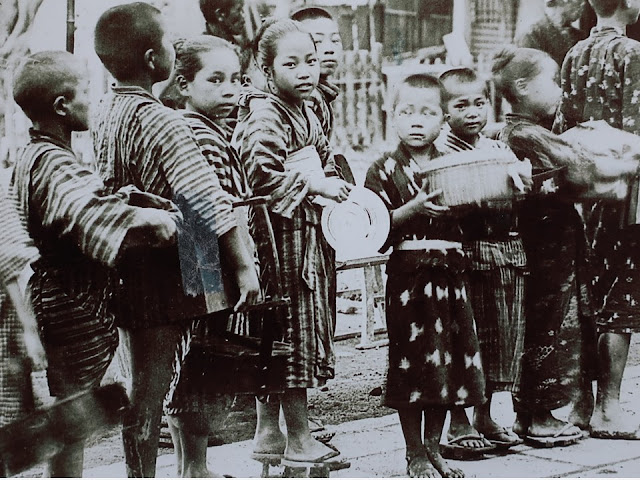The museum is at the foot of Fukuchiyama castle. Tango region is famous for silk and cotton fabrics. Everyday clothes are shown here.
It says, “The clothes are reused by unsewing, redyeing and resewing. Mother’s clothes are changed to her daughter’s ones, kimono is changed to haori coat, ceremonial child clothes are transformed to nagajuban which are worn beneath kimono.
Fabric offcuts are used
to make a pouch or a futon mat; all fabrics are utilized thoroughly. People
have the know-hows and techniques to do it, moreover they have a sense of fun
to create new one.” It is a life with loving and taking care of things.
Actually, my parents gave me fabrics for
kimono which they used. However, we don’t know how to remake kimono; the
technique is being lost, although my mother says that remaking is interesting.
福知山城の直ぐ下にある資料館で、絹と木綿の織物が盛んな丹波の生活衣を紹介しています。
「布は、ほどかれ、染めかえ、縫い直されることにより再生します。母親の着物を娘のものに、着物を羽織に、子供の祝着を長襦袢にと。端裂も繋いで袋物を作ったり、布団表にしたり、無駄なく使いつくされています。そういった知恵や工夫、遊び心やしゃれっ気まで感じられます」と書いていました。丁寧な暮らしですね。
私も親から着物を引き継ぎましたが、うーん、仕立て直す力がない。正直、失われつつある技術だと思います。でも、仕立て直しは、楽しいそうですよ。
Many manual machines such as looms are exhibited. There is an area to make cotton thread by hands. This is an experience-based museum.
たくさんの機織り機と共に、綿繰りして糸を作れるコーナーがあります。体験型です。
Covers of futon mats which were made around 200 years ago: stripe and plaid are popular patterns of Tango handmade cotton fabrics. Thread was dyed before weaving, so people didn’t need to outsource dyeing.
Exhibits are in good preservation because those were for guest’s futon mats.
布団表(江戸~明治時代):丹波の手織木綿の代表的な模様の「縞」は、先に糸を染めてから織るので、紺屋に出さずに家内で布を作れたそうです。
特に、農家の嫁入りで持参した客布団の表は傷みにくいので良い状態で残っています。ほっとする柄ですね。「糸縞」「ちょろけん」「くずし」が丹波の特徴だそうです。
Children in 1907; they wore cotton clothes. They were waiting for food handouts because of a flood disaster. Everyone seemed to be good children. A girl in center probably carried a baby on her back.
木綿を着た子ども達。明治40年、洪水被害の炊き出し受けの行列です。みんな良い子に見えますね。中央の女の子は赤ちゃんを背負っていそうです。
There are called Futamata washi (Japanese paper). There is only one manufacturer now.
二俣和紙、美しいですね。今は1軒しか生産していません。
Fukuchiyama castle、福知山城
The castle tower was rebuilt in 1986 owing to citizen’s donation.
1986年に復元されました。市民が多くの費用を寄付しました。
Look at its stone base. 天守閣です。石垣に注目して下さい。
Ninety tombs are diverted to the pieces of the base; what a merciless behavior it is!
石垣には自然石だけでなく、五輪塔などの石塔も使われています。その数、90点だそうです。心が渇いていた時代なのですね。
Toyoiwai well is 50m depth, and it is deeper than the Yura River, therefore it was a stable water resource at the time of battling.
豊磐井。深さ50mの井戸です。本丸内の井戸としては日本一の深さで、由良川の河床よりも低いと書かれていました。籠城戦の武器ですね。
The rebuilt castle tower is a local museum, but most of exhibits were about Mitsuhide Akechi who built old Fukuchiyama castle and was a hero of popular TV drama at that time. The room for the highest rank samurais is shown in the photo above.
郷土資料館ではありますが、「麒麟がくる」(NHK大河ドラマ)の放映期間中であり、福知山城を築城した明智光秀と城の展示がほとんどでした。上段の間(江戸時代)のモデルです。
Books in the Edo period (1603~1868) are exhibited. This scene is very famous; M. Akechi was slapped by his boss (Nobunaga Oda) in front of other samurais after his admonition.
絵本太閤記三編の五。信長が諫言したした光秀を打ち据えた場面です。たくさんの本が、原本で展示されています。
Btw, M. Akechi is a official mascot of Fukuchiyama. He's all smiles.
ここでは、福知山PR武将・光秀がアニメです。光秀はニコニコですね。
This is the sole exhibit about people’s life; prosperity of Shimo-Funato pier. Fukuchiyama flourished as the transportation base of Yura River. This is made from tobaccos.
庶民に関する展示は一点で、下船戸の賑わいです。江戸時代の福知山は、由良川水運の拠点として発展しました。タバコで作られた作品です。
Reference: Japanese Oni Exchange Museum、日本の鬼の交流博物館
天守から由良川と福知山の街が見えます。由良川漁協があります。川の幸も得られるのですね。遠くの高い山は鬼退治伝説がある大江山です。
I recommend “Yurano-garden” near the car park; seven restaurants are in it. We enjoyed lunch at the open deck.
駐車場近くの「ゆらのガーデン」。オープンテラスでお勧めです。ランチを頂きました。7店舗あります。
Visited in October, 2020
Official
website: https://www.city.fukuchiyama.lg.jp/soshiki/7/2026.html (in Japanese), accessed in February, 2021
Previous post (Local museum in this region) :
Maizuru furusato (hometown) museum、舞鶴ふるさと発見館
Next post(Featured
exhibition sototabe (eating-out)):
National Museum of Japanese History、国立歴史民俗博物館



















Comments
Post a Comment